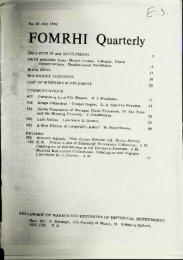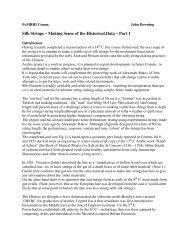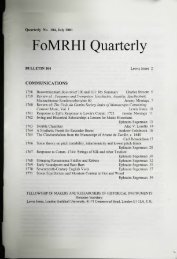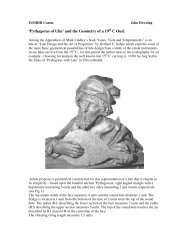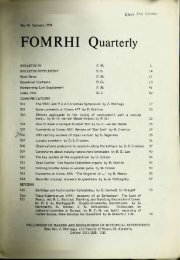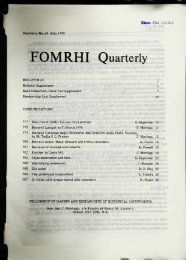•rf - FoMRHI
•rf - FoMRHI
•rf - FoMRHI
You also want an ePaper? Increase the reach of your titles
YUMPU automatically turns print PDFs into web optimized ePapers that Google loves.
Horniman wind instruments, p.4<br />
p.94 continued<br />
Fanfare Trumpet, Carse 249A, see fig.71. C'arse thought this pair<br />
was by Kohler.<br />
Trumpet, Carse 66, io in E fiat, not D, and has a cornet shank in<br />
it and a modem mouthpiece.<br />
Trumpet, Carse 100, is circular!y coiled, rather than folded.<br />
Cavalry Trumpet, Premier, is in high-pitch F.<br />
Trumpet, Sandbach 4 Uyatt, see fig.73* It has 4 crooks.<br />
Trumpet, Pace, Carse 199, is in D.<br />
p.95 Trumpet, Pace, Carse 76, has A crooks.<br />
Trumpet, Bohland & Fuchs, has 2 crooks<br />
Trumpet, Ilahillon, see fig.74* Has high- and low-pitch tuning<br />
slides.<br />
Slide Trumpet, Carse 64, see fig.72. In F.<br />
Slide Trunpet, Kohler, Corse 147. The Perinet valve was added<br />
later. There is a full set of crooks, F-C, and two tuning<br />
bits.<br />
Slide Trumpet, Wyatt. According to Carse, this was made in 1890<br />
(not reconstructed) and was exhibited at the Royal Aquarium<br />
Exhibition in 1892.<br />
Slide Trumpet, Kohler, Carse 71» According to Carse is a Harper's<br />
Improved, and it has a full set of crooks etc. in its<br />
originai box. The mouthpiece is certainly a Harper.<br />
Trombone, Nagel. I am not convinced that this is a reconstruction.<br />
Tubular stays do not justify this description. The beli<br />
of thi3 instrument is rotting to the o.tent that it is<br />
only the coating of lacquer (very thick, like ali the<br />
brass instruments in the Horniman) that is holding it<br />
together. The great puzzle about thic instrument is the<br />
mouthpiece that can be seen in it in ali Carse's illustrations<br />
but that has now vanished; it does not seem to<br />
have been with the instrument when it arrived at the Horniman<br />
in 1947* Is so extraordinary a mouthpiece authentic,<br />
or was it a figment of Carse's imagination?<br />
Trombone, Ricchi. The'part of means that there is only the<br />
beli joint.<br />
Trombone, Bernareggi, see back cover.<br />
Trombone, Courtois, see fig.76<br />
Trombone, ?Van En^elen, see fig.91<br />
Trombone, Keat, see fig.75<br />
Valve Trombone, besson(?) (the registre is marked Besson Breveté),<br />
see fig.77• Th effect of the registre is to lower the<br />
pitch by a 4th.<br />
Valve Trombone, Perdo. Roth, see fig.92<br />
p.96 Bimbonifono. This Carse clansed as a valved bugie, but valve<br />
trombone is more accurate, lt has 5 whole tone and one<br />
semitone decending valves, and one uscenJing semitone valve.<br />
p.97 Hunting Horn, Bull. In fiat pitch F (between E and F modem).<br />
It has its originai ivory mouthpiece.<br />
Horn, Carse 254. In E fiat. RMP said c.1705 English.<br />
Horn, Carse 296. Sharp pitch - produces E with an E fiat crook.<br />
Horn, Startzer. Accoraing to Carse it ha3 the date 1770 on it,<br />
and there are no crooks.<br />
Horn, marked Raoux, Carse 209. According to RMP the crook is not<br />
originai, it is probably not by Raoux, and if it is a<br />
Raoux it is Lueien-Joseph, see fig.60<br />
Horn, Raoux, Carse 166, see fig.81. Cor solo by Lucien-Joceph<br />
Raoux.<br />
Horn, Carse 122. The attribution to Jahn is from RMP, about the<br />
only one of his commenta that has got through.





